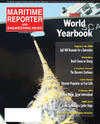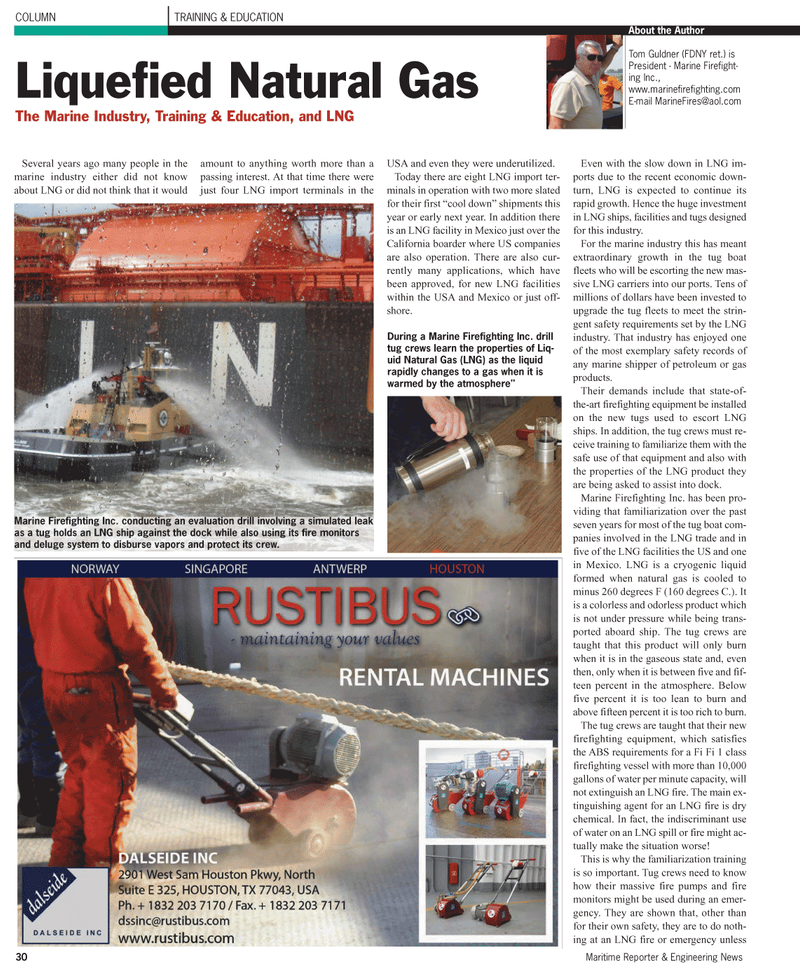
Page 30: of Maritime Reporter Magazine (June 2, 2010)
Read this page in Pdf, Flash or Html5 edition of June 2, 2010 Maritime Reporter Magazine
Several years ago many people in the marine industry either did not know about LNG or did not think that it would amount to anything worth more than a passing interest. At that time there were just four LNG import terminals in the
USA and even they were underutilized.
Today there are eight LNG import ter- minals in operation with two more slated for their first “cool down” shipments this year or early next year. In addition there is an LNG facility in Mexico just over the
California boarder where US companies are also operation. There are also cur- rently many applications, which have been approved, for new LNG facilities within the USA and Mexico or just off- shore.
Even with the slow down in LNG im- ports due to the recent economic down- turn, LNG is expected to continue its rapid growth. Hence the huge investment in LNG ships, facilities and tugs designed for this industry.
For the marine industry this has meant extraordinary growth in the tug boat fleets who will be escorting the new mas- sive LNG carriers into our ports. Tens of millions of dollars have been invested to upgrade the tug fleets to meet the strin- gent safety requirements set by the LNG industry. That industry has enjoyed one of the most exemplary safety records of any marine shipper of petroleum or gas products.
Their demands include that state-of- the-art firefighting equipment be installed on the new tugs used to escort LNG ships. In addition, the tug crews must re- ceive training to familiarize them with the safe use of that equipment and also with the properties of the LNG product they are being asked to assist into dock.
Marine Firefighting Inc. has been pro- viding that familiarization over the past seven years for most of the tug boat com- panies involved in the LNG trade and in five of the LNG facilities the US and one in Mexico. LNG is a cryogenic liquid formed when natural gas is cooled to minus 260 degrees F (160 degrees C.). It is a colorless and odorless product which is not under pressure while being trans- ported aboard ship. The tug crews are taught that this product will only burn when it is in the gaseous state and, even then, only when it is between five and fif- teen percent in the atmosphere. Below five percent it is too lean to burn and above fifteen percent it is too rich to burn.
The tug crews are taught that their new firefighting equipment, which satisfies the ABS requirements for a Fi Fi 1 class firefighting vessel with more than 10,000 gallons of water per minute capacity, will not extinguish an LNG fire. The main ex- tinguishing agent for an LNG fire is dry chemical. In fact, the indiscriminant use of water on an LNG spill or fire might ac- tually make the situation worse!
This is why the familiarization training is so important. Tug crews need to know how their massive fire pumps and fire monitors might be used during an emer- gency. They are shown that, other than for their own safety, they are to do noth- ing at an LNG fire or emergency unless 30 Maritime Reporter & Engineering News
COLUMN TRAINING & EDUCATION
Liquefied Natural Gas
The Marine Industry, Training & Education, and LNG
About the Author
Tom Guldner (FDNY ret.) is
President - Marine Firefight- ing Inc., www.marinefirefighting.com
E-mail [email protected]
During a Marine Firefighting Inc. drill tug crews learn the properties of Liq- uid Natural Gas (LNG) as the liquid rapidly changes to a gas when it is warmed by the atmosphere"
Marine Firefighting Inc. conducting an evaluation drill involving a simulated leak as a tug holds an LNG ship against the dock while also using its fire monitors and deluge system to disburse vapors and protect its crew.

 29
29

 31
31
